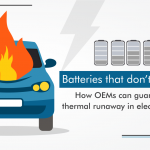How OEMs can get 40% increased battery life for EVs?
One of the most critical components of an Electric Vehicle (EVs) is its battery. The battery is also its most expensive component. EVs come with lithium-ion batteries because of their energy density, higher voltage, and negligible memory effects.
While these advanced batteries in EVs are ideally designed for extended life, they face degradation over time, as pointed out by a recent study conducted by Cox Automotive. As much as 46 percent of those considering an electric car fear the battery pack would last only for 65,000 miles or less. Since most lithium-ion cells are susceptible to degrade or age at or above 60°C, there is a rapid loss of capacity over subsequent charge and discharge cycles. The overall power output also reduces over time.
Another downside of these battery packs is that when electric cars are kept in the hottest climates, they can be expected to lose battery capacity much quicker. This is because lithium-Ion chemistry is extremely sensitive to high temperatures. Heat causes lithium-ion battery packs to degrade much faster than they normally would. In India, where the climate is warm or even hot for more than six months in a year, this becomes a concern.
One of the major solutions to extend the battery life of lithium-ion batteries, even to as much as 40%, is through the use of Latent Heat Systems or LHS. LHS materials can help OEMs in several ways to increase battery life by absorbing and storing thermal energy, thus reducing detrimental thermal effects. LHS materials are being extensively preferred ineffective, simple, and economical thermal management designs for power-intensive lithium-ion battery applications.
(The image above shows the increased cell life due to lower internal degradation due to Outlast LHS® thermal management.)
Another impressive feature of LHS Battery Materials is their ability to reduce and even eliminate the potential for Thermal Runaway in battery packs. Thermal Runaway is a growing safety concern in many applications due to the possibility of a serious fire in case the cells are physically damaged or short-circuited. These materials provide thermal protection to batteries, and electronic devices, along with temperature stabilization of thermosensitive components and surfaces.
It increases battery life by significantly reducing thermal degradation and offering superior thermal mitigation during high charge and discharge cycles. LHS materials help maintain a homogeneous cell temperature across battery packs.
LHS Materials used in a battery pack
LHS Materials are available in a variety of forms including composites, encapsulants, and coatings. These materials can be optimized into sheets and geometric forms to fit your needs. They can be heated and poured into a sealed environment providing exceptional latent heat and flame-retardant properties. These materials are not shaped stable.
For using LHS Materials in your EV battery or for any questions, please feel free to connect with me on ashutosh@quanzen.com






